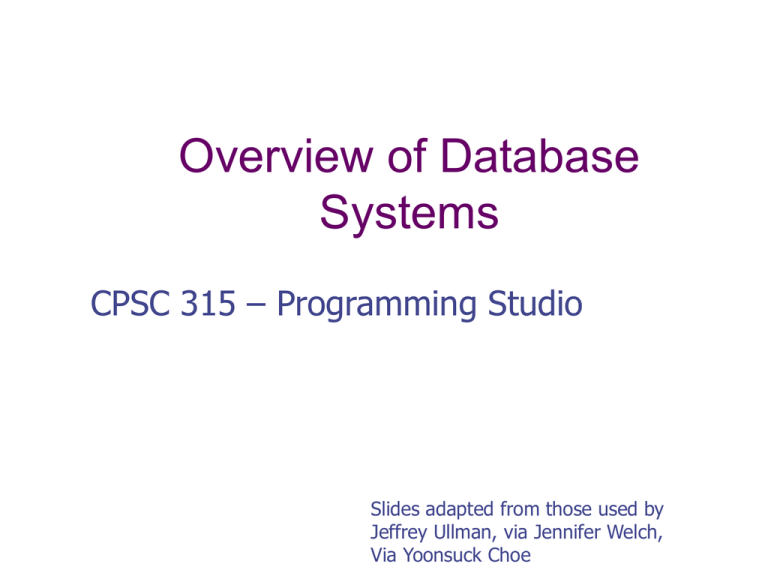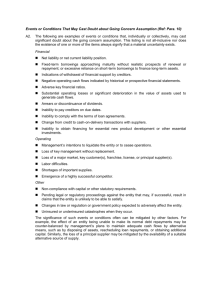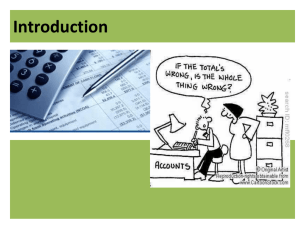Database Systems
advertisement

Overview of Database Systems CPSC 315 – Programming Studio Slides adapted from those used by Jeffrey Ullman, via Jennifer Welch, Via Yoonsuck Choe Database Systems Systems designed to manage very large amounts of data, and to query that data to pull out useful information Often, key considerations include: Efficiency Reliability Ease of access (querying, distributed) Creating a Database A database schema determines what will be represented in the database This should be tightly controlled by a database manager Specified through a data definition language Querying Databases Once database has been populated, users can query the data A data manipulation language controls how the user can specify queries, (and thus what types of queries are allowed) SQL is probably the most well-known Other Database Topics “Real” database courses include lots of other things that we’ll be ignoring here More complete theory behind design Query optimization Efficient storage Processing Transactions – grouped queries that provide atomic operations Scheduling, logging, recovery Entity-Relationship Model Way of expressing (in diagrammatic form) a database design Kinds of data and how they connect Easy first way to think about databases Later, relational model described Entities and Attributes Entities are things Entity sets are collections of those things Attributes are properties of entity sets Entity Sets and Attributes Name Party Senator Bill State Name Years Text Relationships Connect two or more entity sets Name Party Contributed Senator Organization Lobbyist State Years Name Sponsored Wrote Bill Name Text Values of Relationships The “value” of an entity set is the entities it contains The “value” of a relationship is a list of currently related entities (one from each entity set) Senator Bill Smith Tax Bill Smith Defense Bill Jones Tax Bill Multi-Way Relationships E.g. Lobbyist lobbied Senator about Bill Name Party Organization Senator Lobbied State Lobbyist Name Years Bill Name Text Relationship Types Consider binary relationships (two entity groups in a relationship) One-to-one Each entity can have at most one in the other category e.g. entity groups: Baseball player, Team relationship: Team MVP A team can only have one MVP, and a player can only be MVP for one team. Relationship Types Consider binary relationships (two entity groups in a relationship) One-to-one Many-to-one Each entity of first set can go to at most one of the second set e.g. entity groups: Person, Town relationship: BornIn A person can is born in only one town, but a town can have many people born there Relationship Types Consider binary relationships (two entity groups in a relationship) One-to-one Many-to-one Many-to-many Any number from one set to the other e.g. Senators can sponsor many bills, and each bill can be sponsored by many Senators Diagrams of Relationships Arrow shows “to one” Lived In Person Baseball Player Born In Town MVP Team Attributes on Relationships Can be converted to multi-way diagrams Person Born In Hospital Town Attributes on Relationships Can be converted to multi-way diagrams Person Born In Hospitals Hospital Town Attributes on Relationships Note arrows Person Injured Hospitals Hospital Date Roles If multiple references to same entity set, label edges by roles Team Lead Team Programmer Tester Students Subclass Fewer entities, more properties Name Elected Official Party isa U.S. Representative District Subclass Entity in all subclasses Elected Official isa U.S. Representative District isa Republican District Name Keys A key is a set of attributes for an entity set such that no two entities agree on all the attributes. We must have a key for every entity set Elected Official Name Party isa U.S. Representative District For an isa hierarchy, only root can have a key. Key for multiple attributes Must choose one set of attributes First Name Last Name Number Position Baseball Player Birthdate Nationality Salary Team Key for multiple attributes Must choose one set of attributes First Name Last Name Number Position Baseball Player Birthdate Nationality Salary Team Key for multiple attributes Must choose one set of attributes First Name Last Name Number Position Baseball Player Birthdate Nationality Salary Team Weak entity sets Need “help” to determine key First Name Last Name Number Note arrrow: indicates many to one. Position Baseball Player Birthdate Nationality Salary Plays On Team City Name Design Techniques Avoid redundancy First Name Say the same thing two ways Last Name Number Position Baseball Player Birthdate Team Name Salary Plays On Team City Name Design Techniques Avoid redundancy First Name Say the same thing two ways Last Name Number Position Baseball Player Birthdate Team Name Team Town Design Techniques Don’t use entity set if attribute will do Entity lists should either Name Have some non-key attribute Be the “many” in a many-one/many-many relationship Baseball Player Plays On Team City Name Design Techniques Don’t use entity set if attribute will do Entity lists should either Name Have some non-key attribute Be the “many” in a many-one/many-many relationship Baseball Player Team Design Techniques Don’t overuse weak entity sets Usually use unique key for each entity set (e.g. UIN, SSN, VIN) Not always possible, though






